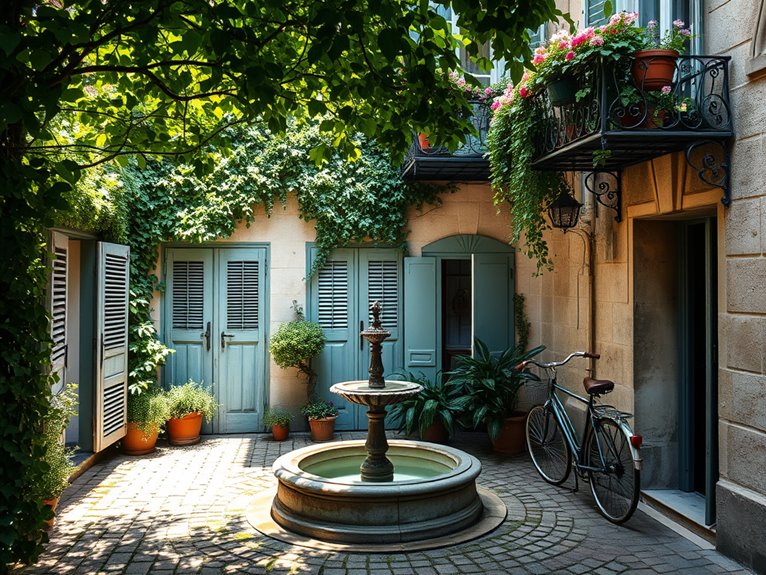
6 Unique Parisian Courtyards Hidden From View
I've discovered six enchanting hidden courtyards in Paris that'll transport you beyond the tourist crowds! From the secret gardens behind Rue de Rivoli to the cobblestone passages of Le Cour Damoye, these urban oases offer glimpses into historic Paris. You'll find medieval charm at Village Saint-Paul, covered arcades at Passage des Panoramas, aristocratic splendor in Le Marais's hotel particuliers, and artistic heritage at Villa des Arts. Let's explore these tucked-away treasures where history and beauty converge.
The Secret Gardens of Rue De Rivoli
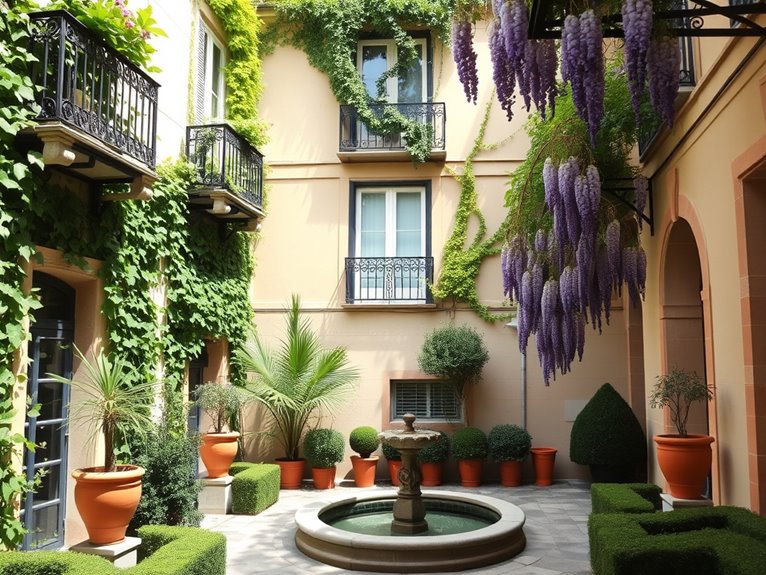
Behind the grand arcaded façade of Paris's iconic Rue de Rivoli lies a world few tourists ever discover – a network of enchanting courtyard gardens that serve as green sanctuaries amid the bustling city center. These private oases, originally designed for aristocratic residences during the early 19th century, offer glimpses into the authentic Parisian lifestyle while providing peaceful retreats from the street's constant activity.
What makes these hidden gardens particularly special is their stark contrast to the formal, tourist-filled Tuileries Gardens directly across the street. While some courtyards remain private, several have been opened to the public through hotels, cafes, and cultural institutions, allowing visitors to experience these secret spaces firsthand – if they know where to look.
Quick Facts:
- Best visiting hours: 10am-6pm (most courtyards)
- Access: Free for some, others require patron status at associated businesses
- Photography: Permitted in public areas, restricted in private spaces
- Peak seasons: Spring (April-May) and Fall (September-October)
- Weather consideration: Most gardens have limited covered areas
- Accessibility: Many courtyards have steps or uneven surfaces
Notable Courtyards:
Le Jardin du 222
A magnificent example of French formal garden design, this courtyard features meticulously maintained topiaries and a central fountain. Located at 222 Rue de Rivoli, it's accessible through the adjacent luxury hotel's café. The garden is particularly stunning during morning hours when sunlight streams through the surrounding buildings. Insider tip: Order a coffee at the café's outdoor seating area for legitimate access to photograph the garden.
Cour des Vosges
Hidden behind an understated archway at 268 Rue de Rivoli, this Renaissance-inspired courtyard showcases classic limestone architecture and seasonal flowering plants. Open daily from 9am-7pm, this public space offers rare quiet moments in central Paris. Unique feature: Look for the restored 17th-century sundial on the southern wall.
Jardin Particulier
A modern interpretation of traditional French gardens, this space at 192 Rue de Rivoli combines contemporary sculpture with historic architecture. Access through the art gallery requires a small purchase. Special note: The garden hosts occasional evening concerts during summer months.
Pro Tips:
For the best photography opportunities, visit during "golden hour" (one hour before sunset) when the light creates magical effects through the surrounding architecture. Consider visiting on weekday mornings to avoid the lunch crowds and guarantee the best chance of having these spaces largely to yourself. Many courtyard gardens are at their most spectacular during spring when magnolias and cherry trees bloom, though autumn offers equally impressive foliage displays.
Practical Advice:
While exploring these hidden gardens, maintain appropriate noise levels and respect private property boundaries. Some courtyards may close without notice for private events or maintenance. It's recommended to have a backup plan and to always ask permission before entering spaces that seem semi-private. Carrying a small umbrella is wise, as sudden weather changes can leave you exposed in these open courtyards.
Le Cour Damoye: A Cobblestoned Time Capsule
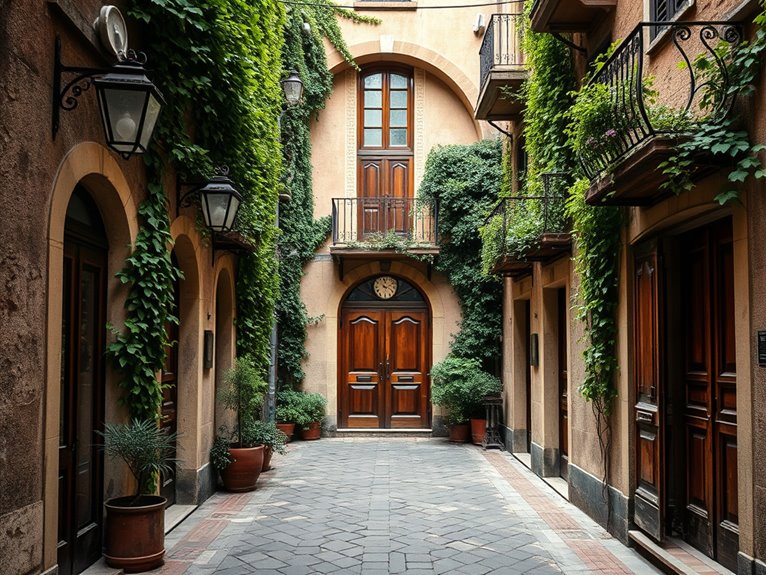
Hidden Parisian Courtyards: Le Cour Damoye
A Cobblestoned Time Capsule
Tucked away in the bustling 11th arrondissement, Le Cour Damoye stands as a showcase to Paris's hidden architectural treasures. This 240-meter-long passageway, dating back to 1789, offers visitors a rare glimpse into historical Paris, with its perfectly preserved cobblestones and distinctive archway entrance that seems to transport pedestrians back in time.
Behind the inconspicuous entrance at 12 Place de la Bastille lies a pedestrian paradise that few tourists ever discover. The narrow passage, flanked by former artisan workshops now converted into creative studios and boutiques, provides a stark contrast to the modern hustle of Place de la Bastille just steps away, making it an essential stop for photographers, history enthusiasts, and those seeking authentic Parisian experiences.
Quick Facts:
- Best visiting hours: 8:00 AM – 7:00 PM (public access)
- Photography: Early morning light best for capturing architecture
- Access: Free entry
- Nearest Metro: Bastille (Lines 1, 5, 8)
- Peak times: Weekday afternoons
- Weather consideration: Cobblestones can be slippery when wet
Historical Architecture
The passage's distinctive wrought-iron entrance gate, adorned with Art Nouveau details, marks the beginning of an architectural journey through time. The buildings lining the courtyard showcase classic Parisian architecture from the late 18th century, with uniform facades featuring original wooden doors and iron balconies. Insider tip: Look for the small brass plaques beside doorways indicating former workshop locations and their trades.
Contemporary Culture
Today's Le Cour Damoye houses an eclectic mix of creative businesses, including graphic design studios, artisanal workshops, and small galleries. Many original workshop spaces have maintained their character while adapting to modern uses. The passage hosts occasional art exhibitions and cultural events, particularly during the summer months. Insider tip: Several workshops open their doors to the public on the first Thursday of each month.
Pro Tips:
The best photographs can be captured during the "golden hour" just after sunrise when the morning light creates dramatic shadows across the cobblestones. Visit on weekday mornings to experience the passage at its most peaceful, when local artists and craftspeople are arriving at their studios. For the most authentic experience, take time to notice the architectural details above eye level, where original features remain largely unchanged since the 18th century.
Practical Advice:
Wear comfortable, flat shoes with good grip, as the historic cobblestones can be uneven and slippery in wet weather. While the passage is public, remember it's also a working space for local businesses – maintain a respectful quiet and ask permission before photographing through windows or open doors. Consider combining your visit with exploration of the neighboring Marais district for a thorough experience of historical Paris.
Village Saint-Paul's Medieval Courtyards
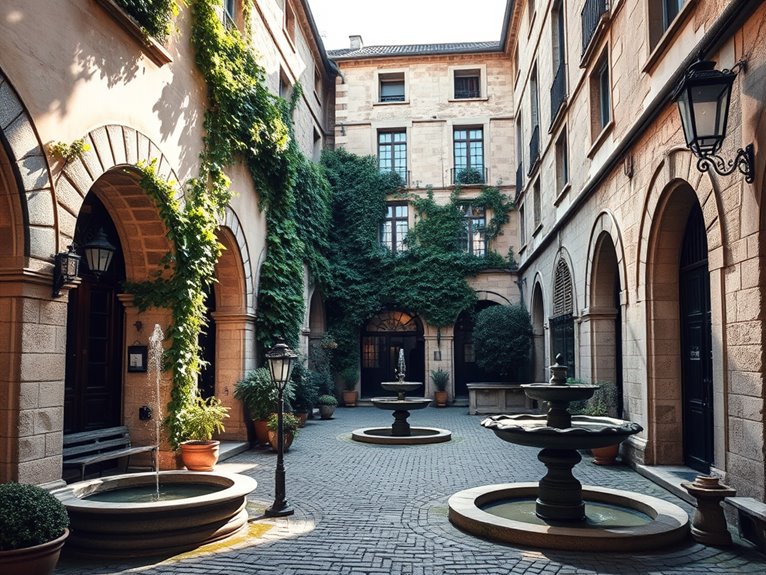
Hidden Medieval Treasures: Village Saint-Paul's Medieval Courtyards
———————————————
Tucked away in the Marais district, the Village Saint-Paul's medieval courtyards offer a fascinating glimpse into Paris's rich historical tapestry. These interconnected passages and courtyards, dating back to the 13th century, once formed part of Charles V's royal residence and have evolved into a mesmerizing labyrinth of antique shops, artisan workshops, and secret gardens.
Walking through these historic courtyards feels like stepping into a time capsule where medieval Paris meets contemporary artistry. The network of four main courtyards – Cour des Lions, Cour du Bel-Air, Cour de l'Homme, and Cour des Trois Frères – creates an intimate village atmosphere that few tourists discover, making it one of Paris's most authentic hidden gems.
Quick Facts:
- Best visiting hours: Tuesday to Sunday, 11:00-19:00
- Peak antique market days: Weekends
- Photography permitted: Yes, but request permission inside shops
- Access: Free
- Nearest Metro: Saint-Paul (Line 1)
- Best lighting for photos: Early afternoon
- Wheelchair accessible: Partially
The Courtyards:
Cour des Lions
A stunning entrance courtyard featuring original medieval stonework and carved medallions. Home to high-end antique dealers specializing in 18th-century furniture. Located at 21 rue Saint-Paul, this courtyard serves as the main gateway to the village. Insider tip: Look for the ancient well, still visible in the corner, which once served the royal residence.
Cour du Bel-Air
The largest of the courtyards, known for its contemporary art galleries and vintage book dealers. Distinguished by its impressive glass-roofed passage and original cobblestones. Houses several cafes with outdoor seating. Secret feature: The decorative door knockers throughout this courtyard are original pieces from the 17th century.
Cour de l'Homme
A more intimate space featuring specialized antique dealers focusing on Art Deco pieces and vintage jewelry. Notable for its perfectly preserved medieval archways and original wooden beams. Hidden gem: The small garden maintained by residents features medieval medicinal herbs.
Cour des Trois Frères
The most picturesque courtyard, with ivy-covered walls and traditional Parisian architecture. Home to artisan workshops and contemporary craft boutiques. Special feature: Look for the original stone markers indicating the high-water marks from historic Seine floods.
Pro Tips:
The Village Saint-Paul comes alive during the first weekend of each month when additional antique dealers set up temporary stalls in the courtyards. Visit between 14:00-16:00 to catch the best light for photography while avoiding the busiest tourist hours. Early morning visits offer the most authentic experience as shop owners arrange their displays and cafes prepare for the day.
Practical Advice:
Many shops close for lunch between 13:00-14:30, and some dealers operate by appointment only. Carry cash for smaller purchases, as not all antique dealers accept cards. While the courtyards are public spaces, remember they're also residential areas – maintain a respectful volume and ask permission before photographing private residences or shop interiors. Consider booking a guided tour through the Marais Historic District Office for deeper historical insights and access to normally closed areas.
The Hidden Oasis of Passage Des Panoramas
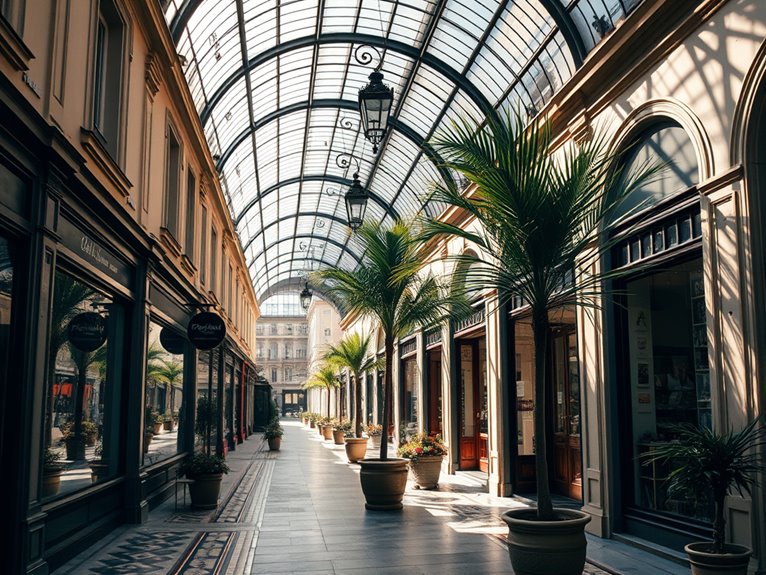
Tucked away in Paris's 2nd arrondissement, Passage des Panoramas stands as the city's oldest covered passage, dating back to 1799. This historic arcade represents a pristine example of early 19th-century Parisian architecture, offering visitors a glimpse into the city's rich commercial heritage while housing an eclectic mix of vintage shops, stamp dealers, and atmospheric restaurants.
Beyond its historical significance, this covered passage serves as a sanctuary from Paris's busy boulevards, creating an intimate atmosphere where time seems to stand still. The glass-roofed gallery, adorned with intricate ironwork and original wood-framed storefronts, creates a magical interplay of light and shadow throughout the day, making it a photographer's paradise and a welcome retreat for those seeking authentic Parisian charm.
Quick Facts:
- Opening Hours: Daily 6:00 AM – 12:00 AM
- Best Visiting Time: Late morning or early evening
- Photography: Natural light is best between 11 AM – 2 PM
- Entrance: Free
- Access Points: 11 Boulevard Montmartre or 158 Rue Montmartre
- Climate: Temperature-controlled, ideal for rainy day visits
- Dining Price Range: €15-45 per person
- Shopping: Most stores closed on Sundays
Notable Features:
Restaurant Bistrot des Panoramas
This traditional French bistro occupies one of the passage's most charming corners, featuring original 19th-century décor and mirrors. Open Tuesday-Saturday, 12:00-14:30 and 19:00-22:30. Reservations recommended for dinner. Insider tip: Request table #7 for the best view of passing pedestrians while maintaining privacy.
Philatélie Stamp Shop
The passage houses several prestigious stamp collectors' shops, with this being the most renowned. Operating since 1890, it offers rare specimens and expert advice. Open Monday-Saturday, 10:00-18:00. Insider tip: The owner conducts free evaluations of vintage stamps every first Tuesday of the month.
L'Arbre à Lettres Bookstore
A carefully curated bookshop specializing in art and architecture publications. Features original wooden shelving from 1850. Open daily 10:00-19:00. Insider tip: Hidden in the back room is a collection of rare Paris maps available for viewing upon request.
Pro Tips:
The passage transforms dramatically throughout the day, with morning light creating stunning photo opportunities through the glass ceiling. Visit between 8:00-10:00 AM to experience the passage coming to life as shopkeepers prepare for the day, or come during the golden hour (around 5:00 PM in winter, 8:00 PM in summer) when the vintage lamps create a magical atmosphere. Weekday mornings offer the most peaceful experience, while weekend afternoons can get crowded with both tourists and locals.
Practical Advice:
While the passage is covered, some spots can be drafty during winter months. Many establishments accept credit cards, but smaller vendors prefer cash. Some shops close for lunch (typically 13:00-14:30), so plan accordingly. The passage connects to several other covered galleries, including Passage Jouffroy and Passage Verdeau, making it ideal for a self-guided walking tour of historic Paris. Consider downloading the passage's official mobile app for detailed historical information and a guided walking tour option.
Le Marais's Aristocratic Hotel Particulier

The grand hôtels particuliers of Le Marais stand as magnificent testimonies to Paris's aristocratic golden age, when noble families constructed lavish private mansions during the 17th and 18th centuries. These architectural masterpieces, with their hidden courtyards and formal gardens, offer visitors a glimpse into the refined lifestyle of French nobility while providing a peaceful escape from the bustling streets of modern Paris.
Behind the imposing carved wooden doors and stone façades lie some of Paris's most enchanting secrets – perfectly proportioned courtyards featuring intricate architectural details, geometric gardens, and centuries-old fountains. While many hôtels particuliers now house museums or government offices, their courtyards remain semi-private spaces that reward curious travelers who venture beyond the main entrances.
Quick Facts:
- Best visiting hours: 10am-6pm (many courtyards close earlier in winter)
- Access: Free for most public courtyards; museum entrance fees vary (€8-15)
- Photography: Allowed in public areas; tripods often restricted
- Most atmospheric season: Spring and early fall
- Accessibility: Most courtyards have cobblestones; some have limited wheelchair access
- Guided tours available: Select properties offer scheduled tours in French and English
Hôtel de Soubise
This magnificent mansion, now home to the National Archives, boasts one of the finest rococo interiors in Paris. The main courtyard features elegant colonnaded walkways and classical statuary. The building houses the Museum of French History.
Location: 60 Rue des Francs-Bourgeois
Hours: Daily except Tuesday, 10am-5:30pm
Insider tip: Visit during archives exhibitions when normally private rooms are opened to the public.
Hôtel Carnavalet
Housing the Museum of the History of Paris, this stunning complex combines two historic mansions. The Renaissance courtyard features ornate sculptural decoration and a formal French garden.
Location: 23 Rue de Sévigné
Hours: Tuesday-Sunday, 10am-6pm
Insider tip: The lesser-known second courtyard often provides quieter photo opportunities.
Pro Tips:
Early morning visits (before 11am) offer the best light for photography and fewer tourists. Many courtyards become naturally lit amphitheaters during this time, highlighting architectural details that might be missed later in the day. Consider visiting during the shoulder season (March-April or September-October) when tourist numbers are lower but the weather remains pleasant for outdoor exploration.
Practical Advice:
While some courtyards are freely accessible, others require either museum admission or advance tour booking. Always check opening hours before visiting, as some properties close for private events or restoration work. Maintain respectful noise levels, as many buildings still house offices or private residences. Carry small change for potential entrance fees, and wear comfortable shoes suitable for walking on historic cobblestones.
The Artist Haven of Villa Des Arts
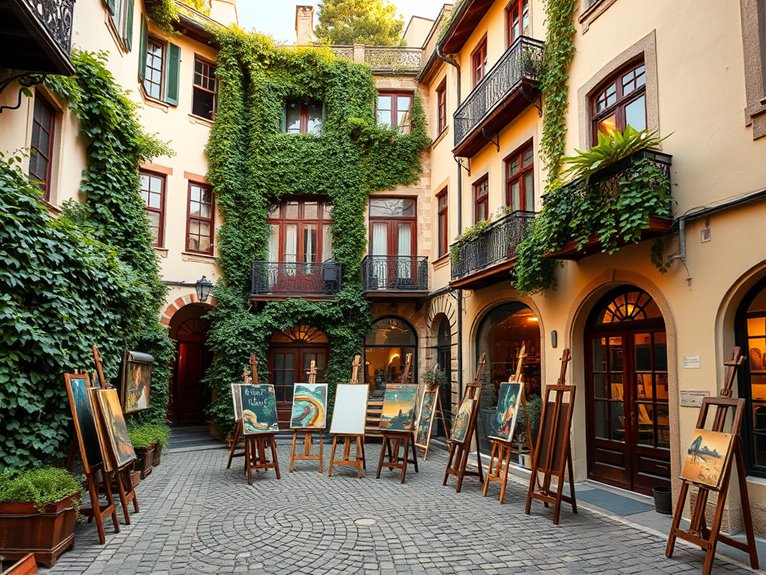
Nestled in the 18th arrondissement of Paris, Villa des Arts stands as a remarkable representation of the city's artistic heritage. This hidden architectural gem, built in 1888-1889 by architect Henri Cambon, consists of 65 artists' studios arranged around a magnificent flower-filled courtyard, offering a rare glimpse into Paris's authentic artistic community.
Originally designed to provide affordable workspace for artists, Villa des Arts has housed renowned creators including Paul Cézanne and Auguste Renoir. Today, this protected historical monument continues its artistic legacy, serving as both residential studios and creative spaces, making it one of Paris's most enchanting yet lesser-known cultural destinations.
Quick Facts:
- Visiting Hours: Monday-Friday, 10:00-17:00 (by appointment only)
- Photography: Permitted in courtyard areas only
- Access: Limited to guided tours or special cultural events
- Location: 15 rue Hégésippe-Moreau, 75018 Paris
- Cost: Free for courtyard viewing; guided tours €15-25
- Best Time: Spring and early summer when the garden is in full bloom
The Central Courtyard
The heart of Villa des Arts features a stunning garden courtyard designed in the Anglo-Norman style. Lush vegetation, carefully maintained flowerbeds, and climbing vines create an otherworldly atmosphere that transports visitors away from urban Paris. The courtyard is accessible through an impressive Art Nouveau gate, which itself is worth photographing. Insider tip: Visit during late afternoon when the light filters through the trees, creating magical photo opportunities.
The Architecture
The complex showcases remarkable late 19th-century architecture, combining elements of Art Nouveau with traditional French design. Each studio features large north-facing windows, designed to provide ideal natural light for artists. The building's façade displays intricate ironwork and decorative elements that reflect the artistic nature of its purpose. Insider tip: Look for the hidden ceramic tiles near the entrance, which contain signatures of past resident artists.
Studio Spaces
Though most studios are private residences, several spaces open to the public during special events like "Journées du Patrimoine" (Heritage Days) in September. These studios maintain their original features, including high ceilings, mezzanine levels, and spectacular glass roofs. Insider tip: Contact the cultural office three months in advance to arrange private studio visits with current resident artists.
Pro Tips:
The best way to experience Villa des Arts is through pre-arranged guided tours, which offer access to areas typically closed to the public. Book well in advance, especially during peak tourist season (June-August). For photographers, early morning tours provide the best lighting conditions and fewer visitors. Consider combining your visit with exploration of nearby Montmartre's artistic heritage sites for a full day of cultural immersion.
Practical Advice:
When visiting Villa des Arts, respect the privacy of current residents by maintaining quiet and following photography restrictions. While the courtyard is technically public, access may be limited without prior arrangement. Contact the property management office or join a reputable architectural tour group for the most thorough experience. Wear comfortable walking shoes as the surrounding area involves hill climbing, and bring a camera with a wide-angle lens to capture the courtyard's grandeur fully.
